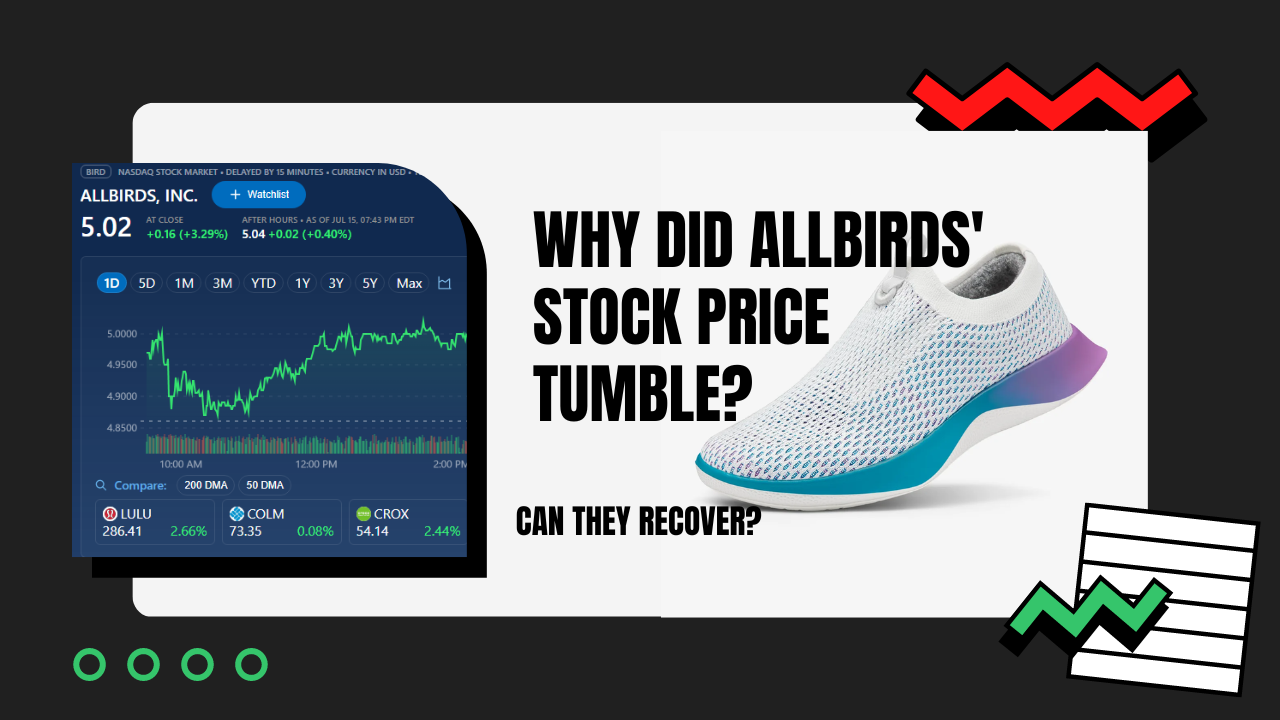![]()
Allbirds was the darling of Silicon Valley. The sneakers became a part of the VC attire. The simple, understated design allowed wearers to feel like they were being more eco-conscious, and the sneakers gave fans a chance to dress sans logos. The eucalyptus fiber and sugar sneaker funded to the tune of a billion-dollar valuation, and that’s where the problem begins. As Allbirds moved towards an IPO, the company showed that it had never turned a profit and the valuation was bloated. Since that first sneaker, Allbirds has rolled out performance sneakers and they even attempted a foray into sneaker culture with Jeff Staple following Nike and Puma by adding the pigeon logo to several colorways of their kicks. (The PumaxStaple collab ended up in outlets for 19.99 which should have been a sign, but at least Allbirds made extremely limited runs of their version.) The company that built its foundation on being a sustainable, simple solution to comfort had overlooked the most important aspects of design: be authentic and memorable.

A few years ago, fashion became about being logo-less. Consumers didn’t want to broadcast how much they paid for their apparel and footwear. In all honesty, this was wrong. Fashion wasn’t about losing the logo, the logo disappeared because of the rise of knit and wool sneakers. A company could sell a sneaker without affixing a logo to it because the weave of the knit, or the fabric itself allowed for cleaner lines and inexpensive manufacturing. An interesting thing happened during the no-logo movement, the sneaker brands controlling the marketplace doubled down on logos. adidas and Nike, even on their premier knit running shoes, placed logos on top of the knit. Those more established companies understood the marketplace. They knew any product that didn’t immediately reference the brand could be easily forgotten. Allbirds stayed simple and rolled out a limited number of SKUs, creating the perfect palette to be stolen and infringed upon.

Pictured are LeMouton shoes on Amazon. Amazon also knocked off Allbirds with their 206 Collective wool sneakers. The lack of design on Allbirds introduced the easiest path to infringement. The irony? LeMouton placed a logo on the footwear. Look at the heel of the shoe in the picture. Allbirds now places their logo on their performance sneakers.
Allbirds’ current stock price is at 4.92. There are whispers of insider trading and the company that was the darling of VCs is now a publicly traded company attempting to find its center. There were opportunities created by Allbirds to offset the issue of knock-offs, but the resources weren’t utilized.

In 2020 a collaborative effort was announced: PENSOLE x Allbirds Could Open Allbirds Up To An Entirely Different Demographic – ARCH-USA There was never a product released from this relationship. In 2021 another partnership was introduced with Pensole: Allbirds x PENSOLE presents Better Responsible Design Program (BRD) – Pensole Design Academy – ARCH-USA It takes time for a product to be created, but after the announcement of this relationship, nothing. Pensole didn’t hold all of the solutions for Allbirds, but when you consider some of the best young designers in the sneaker industry were available to Allbirds as basically interns, this was a chance for learning between the companies. Allbirds got a cooler, younger demographic to gain insight into how the sneaker landscape was laid out, but nothing was developed.
Camper’s Runner K21 Takes NFW MIRUM® and delivers a 100% Natural Sneaker Upper
Allbirds was the first sneaker company to invest in Natural Fiber Welding. Instead of an Allbirds biodegradable upper, leather sneaker dropping, which was incredibly in line with the business, the article above shows Camper was one of the first sneaker companies to roll out an actual product. Following Camper is Nooch Footwear. I’m sure Allbirds is moving towards a release, but right now, nothing. These two distinctly different issues are emblematic of an innovative company freezing and deciding to utilize the same playbook as established brands instead of truly finding a path to better products and better design. How did they freeze?
I.T. Ep. 202 | A Final Look at Allbirds x Staple and if Super Limited Collabs are Worthwhile
Both the failure to work on product with Pensole and the slowness of delivering a new platform with NFW’s Mirum are additional layers, but the inauthentic collab with Jeff Staple is insight into a company searching for an identity, “Are we simple and boring, or are we young and fresh?” The Staple Dasher was freezing. The automatic default of a brand looking for direction is their attempt to tap into sneaker culture. As noted in the first paragraph, simply placing the Staple Pigeon on your kicks, isn’t connecting with sneaker enthusiasts. It’s pandering. This doesn’t build a long-term relationship and create new fans, it creates hype. The reality, beyond one limited hype drop is Allbirds’ manufacturing took a shot because of supply chain issues and the simple design allowed for Amazon to eat into the company’s growth. Why Allbirds is struggling is a pie sliced in too many sections.

There are solutions. Allbirds can expand product offerings and develop more challenging design. They have already begun to offer apparel, but the design remains too simplistic. They can develop more distribution wholesale partnerships or take on a small store format in key cities. Allbirds isn’t a broken company. To the contrary. They are a series of small moves away from climbing back. The recent adidas collab shows that the brand recognizes sustainability can be cool. When Allbirds decides to double down on educating the consumer vs placating the consumer with topical eco information, the company could find its way. If they follow Deckers and Merrell’s leads, both companies created testing labs, vs imitating Puma and Nike with hype collabs, they move forward. The share price is reflective of what the company is. Allbirds could make it reflective of where they are going.

